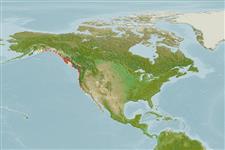Common names from other countries
Environment: milieu / climate zone / depth range / distribution range
Οικολογία
; εύρος βάθους 12 - 45 m (Ref. 865). Subtropical
Eastern Pacific and Northeast Atlantic: Alaska to Kola Peninsula, Russia.
Length at first maturity / Μέγεθος / Βάρος / Age
Maturity: Lm ? range ? - ? cm Max length : 15.0 cm WD αρσενικό/απροσδιόριστο; (Ref. 865)
Size refers to crown diameter (Ref. 865). Solitary (Ref. 2377). It is found attached to rocks, but usually buried partially in sand and shell debris (Ref. 865).
Life cycle and mating behavior
Γεννητική Ωρίμανση | Αναπαραγωγή | Γεννοβολία | Αβγά | Γονιμότητα | Προνύμφες
Members of the class Anthozoa are either gonochoric or hermaphroditic. Mature gametes are shed into the coelenteron and spawned through the mouth. Life cycle: The zygote develops into a planktonic planula larva. Metamorphosis begins with early morphogenesis of tentacles, septa and pharynx before larval settlement on the aboral end.
Cairns, S.D., D.R. Calder, A. Brinckmann-Voss, C.B. Castro, D.G. Fautin, P.R. Pugh, C.E. Mills, W.C. Jaap, M.N. Arai, S.H.D. Haddock and D.M. Opresko. 2003. (Ref. 1663)
IUCN Red List Status (Ref. 130435)
CITES status (Ref. 108899)
Not Evaluated
Not Evaluated
Threat to humans
Harmless
Human uses
| FishSource |
Εργαλεία
Περισσότερες πληροφορίες
Age/Size
Αύξηση
Length-weight
Length-length
Μορφολογία
Προνύμφες
Αφθονία
Διαδικτυακές πηγές
Estimates based on models
Preferred temperature
(Ref.
115969): 8.6 - 12.3, mean 9.7 (based on 24 cells).
Price category
Unknown.
